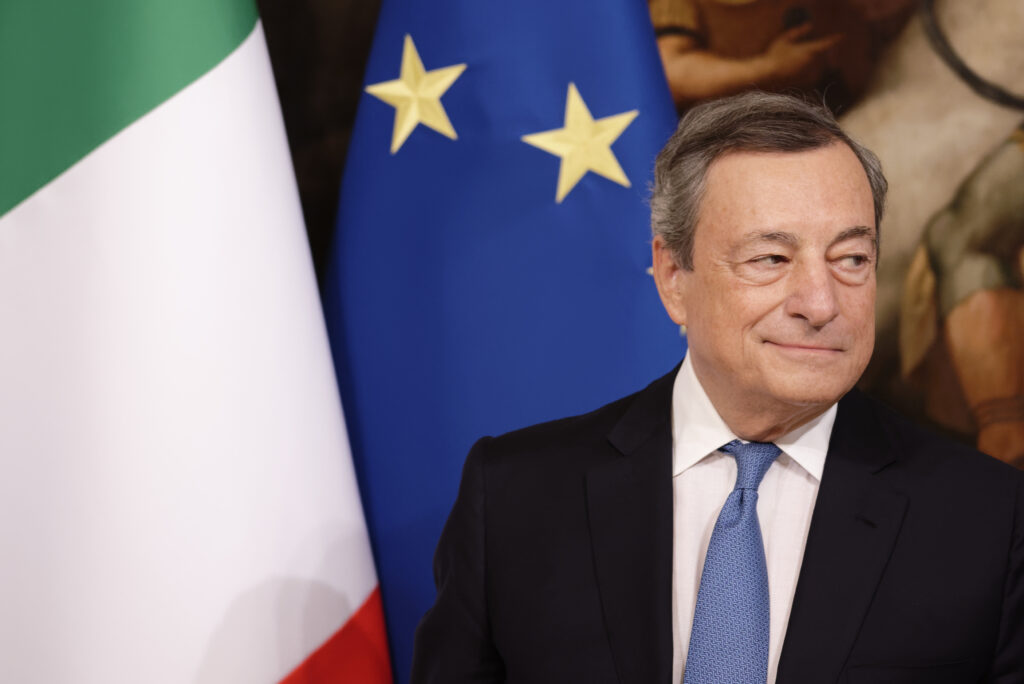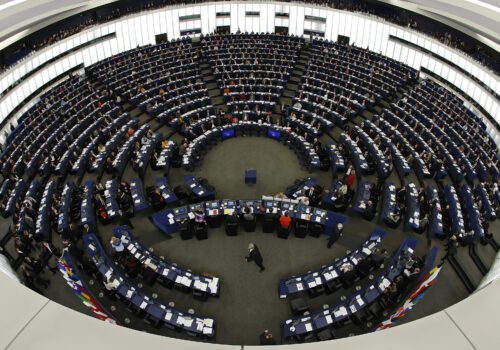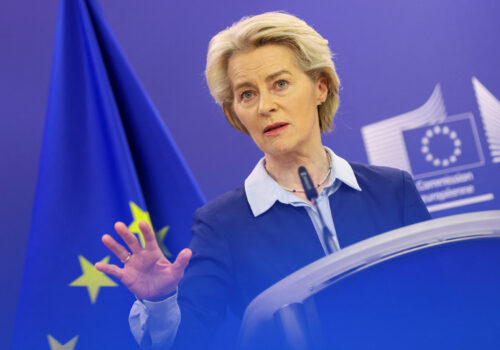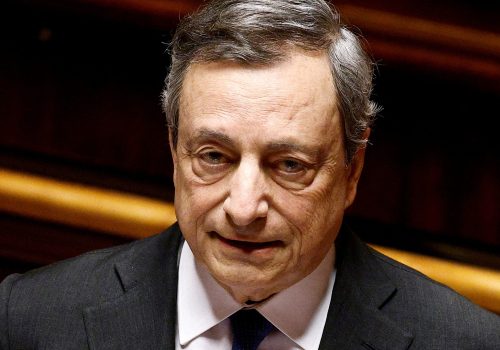The European Union (EU) is at a crossroads: It must choose either to enact significant reforms or accept its impending decline. One of the few leaders willing to make much-needed reforms is Mario Draghi, the former president of the European Central Bank and former prime minister of Italy. As European Central Bank president from 2011-2019, Draghi is widely credited with having deftly handled the European debt crisis and preserving the euro. Having saved Europe once before, he could be the one to help Europe face today’s geopolitical crises.
It starts with Draghi’s forthcoming report on EU competitiveness, at the request of European Commission President Ursula von der Leyen, to be published after the June 6-9 elections for the European Parliament. According to a source close to Draghi, who shared early details on condition of anonymity, the report will likely include a frank appraisal of Europe’s weaknesses. Brussels should pay close attention, and lawmakers should elevate Draghi to be the next European Council president to help make his report’s prescriptions for a more integrated and competitive EU a reality.
Time to compete
The most important things that happen in the world don’t happen in Europe; this is especially true regarding the economy and technological innovation. Draghi is strongly convinced of this, and the competitiveness report will likely dive into Europe’s limited creative and productive capacities.
Draghi is set to deliver a cold, hard dose of reality: Right now, Europe lacks both the resources and the will to compete with the rest of the world, especially considering the capacity of the United States and China to stimulate the economy through government spending. But the report will also likely highlight the fact that Europe has tremendous opportunities to correct for these shortcomings.
One reform that the document will promote is the establishment of interconnections between national production systems, with a view toward creating a single European system of integrated continental supply chains—an ambitious aim, to say the least. “The geopolitical, economic model upon which Europe has rested since the end of the second world war is gone. The European Union has to become a state,” Draghi said at the end of November. His vision for Europe entails the establishment of public debt, fiscal policy, and defense as the pillars of the new EU. He is also convinced that the EU needs five hundred billion euros per year to lead environmental and digital transitions and to provide social protection to its citizens.
As Draghi said in Washington in February, European countries will require “more investment even at the cost of higher public deficits to stimulate growth and fight inequality without forgetting the importance of raising productivity and to assign a new role of budgetary policy that reaches where monetary policy alone cannot reach.”
Draghi is widely regarded as, above all, a defender of European interests and an Atlanticist. As Italian prime minister, he was a key player in aligning Europe with Ukraine. Moreover, he personally developed the system of sanctions placed on Russia’s central bank. This demonstrates a strong track record for defending the EU’s freedom and democracy against any threats.
Draghi’s vision could be the source of inspiration for a government program for the EU for the next five years. And Europe needs his engagement to realize these aims.
The next Council president?
How might Draghi engage with the European institutions? Many observers in Brussels and across the continent think that he could be the next president of the European Council. Even though this institutional office is often criticized for being largely symbolic and lacking a cabinet, it’s the person that makes the office. The president sets the agenda of the Council and could be more than an honest broker between national leaders. A president with Draghi’s vision could truly lead. For example, as European Council president, Draghi would be able to start the process of reforming the EU’s founding treaties by proposing items in formal and informal discussions, as well as crafting plans to realize the policies he will suggest in his report. As he said in Brussels at the High-level Conference on the European Pillar of Social Rights on April 16, “we will need a renewed partnership among member states—a re-defining of our union that is no less ambitious than what the founding fathers did seventy years ago with the creation of the European Coal and Steel Community.”
The problem is that, for now, Draghi has said publicly that he is not interested in assuming any European office, and no political leaders are asking him to get involved.
The campaign for European Council president will start after the elections in June. The new balance of power between the European parties will be determined, together with their agreement on who will hold the main European offices. Three parties that are likely to contend for a leading role in the EU institutions are the European People’s Party (EPP), the Socialists and Democrats (S&D), and Renew Europe (Liberals).
The EPP is expected to be the largest group in the European Parliament. Draghi has a strong influence on the EPP’s leader, von der Leyen, who could ask him at the very least to go on with his work on competitiveness. However, the EPP—mainly the northern European members—are not too keen on the idea of “good debt” that Draghi proposes.
S&D is likely to nominate former Portuguese Prime Minister Antonio Costa as president of the European Council, but he might not be proposed by his country, in which case the nomination would not move forward. During the Socialist Congress in Rome, one of the main leaders, secretary of the Italian Democratic Party Elly Schlein, publicly supported Draghi’s plan to spend five hundred billion euros per year for environmental and digital transitions. And the former Italian prime minister is highly respected by two other influential S&D members: Spanish Prime Minister Pedro Sánchez and German Chancellor Olaf Scholz.
In addition, Draghi has a strong relationship with French President Emmanuel Macron, the leading voice of the Renew Europe group. According to a source close to Macron, his support for Draghi will depend on the outcome of French president’s talks with other European leaders after June 9. The sense is that Macron considers von der Leyen a good choice for a second term as commission president, despite the two campaigning against one another and having disagreements on specific issues. And if von der Leyen backs Draghi, that will bring Macron along, too.
Concerning the other parties, it looks like it will be difficult for the Conservatives and Reformists Party (ECR) to enter into a coalition together with the Socialists. But ECR leader and Italian Prime Minister Giorgia Meloni already has a strong relationship with von der Leyen, and proposing the pro-European Draghi for president of the European Council might be a way to strengthen her accountability with EU partners. Whatever happens after June 9, Europe will need, to paraphrase a quote often attributed to Henry Kissinger, a leader able to carry the European Union from where it is to where it has not been. Draghi could provide that kind of leadership as president of the European Council.
Mario De Pizzo is a nonresident senior fellow at the Atlantic Council’s Europe Center. He is currently a journalist at TG1, Italy’s flagship television newscast program produced by RAI, Italy’s national public broadcasting company.
Further reading
Mon, Apr 15, 2024
Your primer on the European Parliament elections and how they will shape the EU
Eye on Europe's elections By
As Europe heads to the polls to elect the 10th European Parliament this June, the Europe Center is breaking down the key people and issues to know.
Sun, Apr 7, 2024
Ursula von der Leyen set Europe’s ‘de-risking’ in motion. What’s the status one year later?
New Atlanticist By Jörn Fleck, Josh Lipsky, David O. Shullman
The European Commission president presented a new economic vision for the European Union’s relationship with China in March 2023.
Thu, Jul 21, 2022
Mario Draghi, and Italy’s political stability, are gone. What’s next for Europe?
New Atlanticist By
Draghi's resignation sent shockwaves through a European political establishment whose very stability he helped ensure.
Image: Italy's outgoing prime minister, Mario Draghi waves after the cabinet minister bell handover ceremony at Palazzo Chigi in Rome on October 23, 2022. Photo by Massimo Valicchia/NurPhoto.



